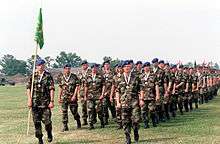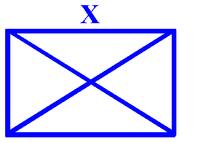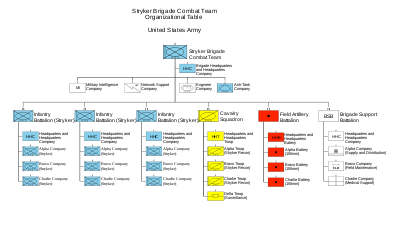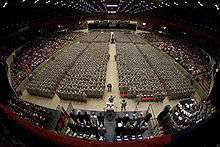Brigade
A brigade is a major tactical military formation that is typically composed of three to six battalions plus supporting elements. It is roughly equivalent to an enlarged or reinforced regiment. Two or more brigades may constitute a division.
| Military organization Talk·View | ||
|---|---|---|
 | ||
| Typical units | Typical numbers | Typical commander |
| fireteam | 2–4 | lance corporal / corporal |
| squad / section |
5–14 | corporal / sergeant / staff sergeant |
| platoon / troop |
15–45 | second lieutenant / first lieutenant / lieutenant |
| company / battery / squadron |
80–250 | first lieutenant / captain / major |
| battalion / cohort |
300–1000 | lieutenant colonel / major |
| regiment / brigade / legion |
1,000–5,500 | colonel / brigadier general |
| division | 10,000–25,000 | major general |
| corps | 30,000–50,000 | lieutenant general |
| field army | 100,000–300,000 | colonel general / general |
| army group / front |
2+ field armies | field marshal / general / admiral |
| region / theater |
4+ army groups | marshal of the air force / general of the army / admiral of the fleet |

Brigades formed into divisions are usually infantry or armored (sometimes referred to as combined arms brigades). In addition to combat units, they may include combat support units or sub-units, such as artillery and engineers, and logistic units or sub-units. Historically, such brigades have sometimes been called brigade-groups. On operations, a brigade may comprise both organic elements and attached elements, including some temporarily attached for a specific task.
Brigades may also be specialized and comprise battalions of a single branch, for example cavalry, mechanized, armored, artillery, air defence, aviation, engineers, signals or logistic. Some brigades are classified as independent or separate and operate independently from the traditional division structure. The typical NATO standard brigade consists of approximately 3,200 to 5,500 troops. However, in Switzerland and Austria, the numbers could go as high as 11,000 troops. The Soviet Union, its forerunners and successors, mostly use "regiment" instead of brigade, and this was common in much of Europe until after World War II.
A brigade's commander is commonly a major general,[note 1] brigadier general, brigadier or colonel. In some armies, the commander is rated as a general officer. The brigade commander has a self-contained headquarters and staff. The principal staff officer, usually a lieutenant colonel or colonel, may be designated chief of staff. Until the late 20th century British and similar armies called the position 'brigade-major’ and most British brigades have a major as the chief of staff. Some brigades may also have a deputy commander. The headquarters has a nucleus of staff officers and support (clerks, assistants and drivers) that can vary in size depending on the type of brigade. On operations, additional specialist elements may be attached. The headquarters will usually have its own communications unit.

In some gendarmerie forces, brigades are the basic-level organizational unit.
Origin
"The brigade as a military unit came about starting in the 15th century when the British army and militia developed a unit to control more than one infantry regiment or cavalry squadron".[1] Previously each regiment, battalion, cavalry squadron, or artillery battery operated somewhat independently, with its own field officer (i.e., colonel, lieutenant colonel, or major) or battery commander (usually a captain) reporting directly to the field force or "army" commander. As such a "field army" became larger, the number of subordinate commanders became unmanageable for the officer in general command of said army, usually a major general, to effectively command. In order to streamline command relationships, as well as effect some modicum of tactical control, especially in regard to combined arms operations (i.e., those involving a coordination of infantry with cavalry and/or artillery forces), an intermediate level of command came into existence.
"The term's origin is found in two French roots, which together, meant roughly 'those who fight' ".[2] Another theory for derivation of the term brigade derives from Italian brigata, as used for example in the introduction to The Decameron, where it refers only to a group of ten, or Old French brigare, meaning "company" of an undefined size, which in turn derives from a Celtic root briga, which means "strife". The so-called "brigada" was a well-mixed unit, comprising infantry, cavalry and normally also artillery, designated for a special task. The size of such "brigada" ranged from a reinforced "company" of up to two regiments. The "brigada" was the forerunner of the modern "battalion task force", "battle group", or "brigade".
The Swedish king Gustavus Adolphus improved the brigade as a tactical unit, introducing it in 1631 during a reorganization of the Swedish Army in the course of the Thirty Years' War. The invention of the brigade overcame the lack of coordination inherent in the traditional army structure consisting of independent regiments of infantry and units of supporting arms (viz., cavalry and artillery) acting separately under their individual commanding officers. Gustavus Adolphus accomplished this battlefield coordination by combining battalions of infantry with cavalry troops and artillery batteries into a "battle group", viz., brigada or "brigade" commanded by a senior colonel, or lieutenant colonel, appointed as a brigadier-general.
In France, Marshal Turenne (1611-1675) copied the brigade organization ; he made it a permanent standing unit, requiring the creation in 1667 of a permanent rank of brigadier des armées du roi (literally translating to "brigadier of the armies of the king"). Unlike the Swedish brigades, French brigades at that time comprised two to five regiments of the same branch (brigade de cavalerie, brigade d'infanterie etc.). The rank, intermediate between colonel and maréchal de camp, disappeared in 1788 and should not be confused with that of général de brigade, which is equivalent to a brigadier general. (A modern général de brigade is referred to occasionally as brigadier.)
Individual armies
Argentina
In the Argentinian Army, the typical brigade is composed of an HQ company, two or three battalions (called "regiments" for historical reasons) of the brigade´s main branch (infantry or armoured cavalry), which give the brigade its denomination (mechanized, armoured, airborne, mountain or jungle), plus one battalion of the other branch, plus one or two artillery groups, an engineers battalion or company, a signals company, and intelligence company, an army aviation section and a logistics battalion. Mountain brigades have also a special forces (called "Mountain rangers") company. The brigade is usually commanded by a brigadier general or a senior colonel, who may be promoted to general during his tenure as brigade commander.
Australia
In the Australian Army, the brigade has always been the smallest tactical formation, since regiments are either administrative groupings of battalions (in the infantry) or battalion-sized units (in the cavalry). A typical brigade may consist of approximately 5,500 personnel between two mechanised infantry battalions, an armoured regiment, an armoured artillery regiment, and other logistic and engineering units. The brigade is usually commanded by an officer holding the rank of brigadier, who is referred to as the "Brigade Commander".
India
In Indian army, Brigade consists of three battalions along with supporting troops .Brigade is commanded by an army officer of the rank of Brigadier (Single star commander). [3]
Pakistan
A brigade is under the command of a brigadier and comprises three or more battalions of different units depending on its functionality. An independent brigade would be one that primarily consists of an artillery unit, an infantry unit, an armour unit and logistics to support its actions. Such a brigade is not part of any division and is under direct command of a corps.
There are 7 independent armoured brigades, seven engineering brigades and eight air defense brigades. Independent armoured and infantry brigades are capable of extended operations without necessarily being reliant on a higher HQ for short-term logistic or intimate support. They can be used in counter-attack, exploitation of an advance, or rapid movement to reinforce formations under pressure.
France
France replaced its divisions with brigades in 1999 (so for example the 2nd Armored Division became the 2nd Armored Brigade). It was decided in 2016 to again form two divisions (1st and 3rd) made up of four and three brigades for a total of seven brigades: two armored, two "intermediate", two light brigades (alpine and parachute) and the Franco-German Brigade. There is also an airmobile brigade subordinated to the army aviation command.
In peacetime, brigades serve primarily as force providers. The units deployed (battlegroups and task-forces) are battalion-size units provided by the regiments composing the brigades.
United Kingdom
Brigades, with a field not a regional administrative role, have usually been of a named type and numbered since the 19th century (e.g. cavalry brigade or infantry brigade). Since the end of World War II, brigade numbers have been unique and not by type. Brigades in divisions do not usually command their combat support and combat service support units. These remain under divisional command, although they may be permanently affiliated with a particular brigade (as a "brigade group"). Historically, infantry or cavalry/armoured brigades have usually comprised three or four combat-arm battalions, but currently larger brigades are normal, made larger still when their affiliated artillery and engineer regiments are added.
Until 1918, the chief of staff of a brigade was known as a brigade major. Before 1922, British Army brigades were normally commanded by general officers holding the "one-star" rank of brigadier-general; after that date, the appointment became that of brigadier, usually held by a field officer with the substantive rank of colonel.
From 1859 to 1938, "brigade" ("brigade-division" 1885–1903) was also the term used for a battalion-sized unit of the Royal Artillery. This was because, unlike infantry battalions and cavalry regiments, which were organic, artillery units consisted of individually numbered batteries that were "brigaded" together. The commanding officer of such a brigade was a lieutenant colonel. In 1938, the Royal Artillery adopted the term "regiment" for this size of unit, and "brigade" became used in its normal sense, particularly for groups of anti-aircraft artillery regiments commanded by a brigadier.[4]
In the Second World War, a tank brigade comprised three tank regiments and was equipped with infantry tanks for supporting the infantry divisions. Armoured brigades were equipped with cruiser tanks or (US Lend-Lease) medium tanks and a motorised infantry battalion. The armoured divisions included one or more armored brigades.
Canada
The Canadian Army currently has three Regular Force brigade groups, designated as Canadian mechanized brigade groups (CMBG): 1 CMBG, 2 CMBG, which contain the regular army's Anglophone units, and 5 CMBG, the regular Francophone formation. These CMBGs are each composed of:
- two mechanized infantry battalions
- one light infantry battalion
- one armoured regiment
- one mechanized artillery regiment
- one engineer regiment
- one combat service and support (CSS) battalion.
Co-located with each CMBG is a field ambulance, and a tactical helicopter squadron, and a military police platoon. Regular Force CMBG strengths are 5,000 personnel.[5] Canada also has ten Primary Reserve brigades (Canadian brigade group, CBG), 31 CBG through 39 CBG, and 41 CBG. The CBG formations are for administrative purposes.
Republic of China (1911–1947)
An NRA Brigade, 旅 (lǚ), was a military formation of the Chinese Republic's National Revolutionary Army. Infantry and cavalry brigades were composed of two infantry regiments. After the 1938 reforms, the brigade was dispensed with within the infantry division in favor of the regiment to simplify the command structure.[6]
United States

Army
In the United States Army, a brigade is smaller than a division and roughly equal to or a little larger than a regiment. During the American Civil War infantry brigades contained two to five regiments with the idea being to maintain a unit with a strength of 2,000 soldiers[7] and were usually commanded by a brigadier general or a senior colonel. During World War I the division consisted of four regiments divided into two brigades of two regiments each.
More recently, the U.S. Army has moved to a new generic brigade combat team (BCT) in which each brigade contains combat elements and their support units. After the 2013 reform, BCT personnel strength typically ranges from 4,400 personnel for infantry BCTs, to 4,500 personnel for Stryker BCTs, to 4,700 personnel for armored BCTs. This formation is standard across the active U.S. Army, U.S. Army Reserve, and the Army National Guard.
The brigade commander is usually a colonel, although a lieutenant colonel can be selected for brigade command in lieu of an available colonel. A typical tour of duty for this assignment is 24 to 36 months. Separate brigades, viz., brigades not permanently assigned to a division, were commanded by brigadier generals[8]
A brigade commander enjoys a headquarters and staff to assist them in commanding the brigade and its subordinate battalion units. The typical staff includes:
- a brigade executive officer, usually a lieutenant colonel (if commanded by a colonel)
- a brigade command sergeant major
- a personnel officer (S1), usually a major
- an intelligence officer (S2), usually a major
- an operations officer (S3), usually a lieutenant colonel
- a logistics officer (S4), usually a major
- a plans officer (S5), usually a major
- a communications officer (S6), usually a major
- a medical officer, usually a major
- a legal officer (JAG), usually a major
- a brigade chaplain, usually a major
In addition, the headquarters includes additional junior staff officers, non-commissioned officers, and enlisted support personnel in the occupational specialties of the staff sections; these personnel are ordinarily assigned to the brigade's headquarters and headquarters company.
Marine Corps
In the United States Marine Corps, brigades are designated as Marine Expeditionary Brigades (MEB), and are usually commanded by a brigadier general. The MEB is a mid-level Marine Air-Ground Task Force (MAGTF) essentially forming a "demi-division". The MEB organizational structure consists of a minimum of three regimental-equivalent sized units and a command element (a Regimental Combat Team, a Composite Marine Aircraft Group, a Marine Logistics Regiment, and a MEB Headquarters Group). Each Marine Expeditionary Force (MEF) contains a MEB, available for deployment on expeditionary duty. The MEB is the intermediate MAGTF between the MEF and the Marine Expeditionary Unit (MEU). Along with the Marine Infantry Regiments, the MEU, (while smaller than an army brigade), are the USMC organizational equivalents of army brigades. The MEU consists of three battalion-equivalent sized units and a command element (a Battalion Landing Team, a Marine Medium Tilt-rotor Squadron (Reinforced), a Combat Logistics Battalion, and a MEU Headquarters Group). The Marine Infantry Regiments, combined with the Marine Artillery Regiments, comprise the bulk of the Marine Divisions. An example of a MEB is Task Force Tarawa (2nd Marine Expeditionary Brigade) during the Operation Iraqi Freedom campaign.
Notes
- Brazil, Portugal, Japan, and the Republic of China on Taiwan
References
- The Brigade: A History: Its Organization and Employment in the US Army, Chapter 1, Brigades in the Continental Army, Colonial Background, p. 1. http://usacac.army.mil/cac2/cgsc/carl/download/csipubs/Brigade-AHistory.pdf. Retrieved 21 December 2016.
- The Brigade: A History: Its Organization and Employment in the US Army, Introduction, p. xi. http://usacac.army.mil/cac2/cgsc/carl/download/csipubs/Brigade-AHistory.pdf. Retrieved 21 December 2016.
- "STRUCTURE OF ARMY". indianarmy.nic.in. Retrieved 22 January 2020.
- Maj-Gen Sir John Headlam, The History of the Royal Artillery, Vol II (1899–1914), Woolwich: Royal Artillery Institution, 1937.
- Canada, Senate of. "Senate of Canada - Committees". Senate of Canada.
- Hsu Long-hsuen and Chang Ming-kai, History of The Sino-Japanese War (1937–1945) 2nd Ed. ,1971. Translated by Wen Ha-hsiung , Chung Wu Publishing; 33, 140th Lane, Tung-hwa Street, Taipei, Taiwan Republic of China.
- p. 17 The Brigade: A History, Its Organization and Employment in the US Army DIANE Publishing
- The Brigade: A History: Its Organization and Employment in the US Army, Chapter 6, The Early Modern Brigade, 1958-1972, ROAD Brigades and Airmobile Brigades, p. 63 and Appendix 1, Divisional Versus Separate Brigades, p. 159. http://usacac.army.mil/cac2/cgsc/carl/download/csipubs/Brigade-AHistory.pdf. Retrieved 21 December 2016.
Bibliography
- (in French) Nouveau Larousse illustré, undated (early 20th century)